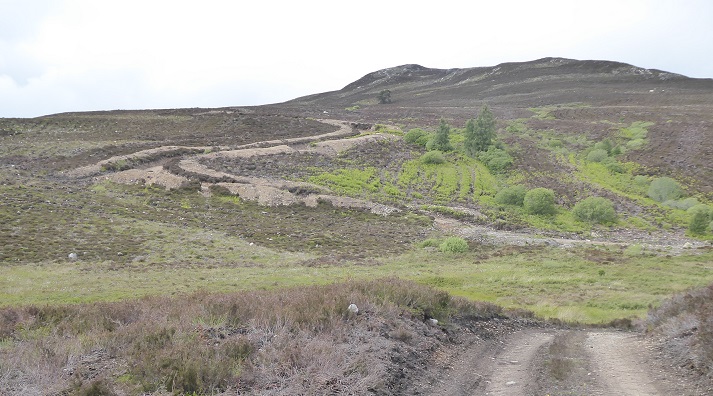
Following my post on the disastrous new section of road at Muckrach (see here), the Cairngorms National Park Authority (CNPA) informed me that they weren’t aware of the work but were now looking into it. I then heard from another source that the CNPA were due to meet with Savills, who oversaw the whole Muckrach woodland creation project, and subsequently that work has now started “to repair” the damage.
The problem is that once damage is done to soils, whether by the creation of tracks or mounding to plant trees, it cannot be restored, only mitigated. Moreover, where the rules are ignored and irreparable damage done, no-one is ever held to account for this, not even in what is supposed to be a National Park.
This post will consider how a project that appears to have started with good intentions has ended up causing so much damage to the natural environment in the Cairngorms National Park
Background and purpose of the Muckrach tree planting project

Muckrach is, according to Who Owns Scotland, owned by the Trustees of Richard H & Niall Hamilton Anstruther-Gough-Calthorpe. It is part of the Calthorpe Group, whose interests are concentrated in the Egbaston area of Birmingham. There is an excellent brief history on the Calthorpe Group website (see here) which describes how, over the course of 300 years, the Calthorpe Estate was transformed from a rural to an urban business, focusing on property investment and development, while remaining in the hands of the same family.
Muckrach was bought by Calthorpe Estates in the 1960s, as explained in their background to the tree planting project (see here). They describe the three primary businesses at Muckrach prior to that as being “farming, forestry and residential property”. This suggests that the intensive management of a large part of the estate for grouse shooting was for the family’s private pleasure, not profit. Being, however, “a progressive property investment and development company,” it appears the family firm started to think about climate change and how it might meet net zero. It then saw an opportunity to use the land it owned at Muckrach to offset its carbon emissions down in Birmingham. It looked like a win-win, “a landscape-scale project, contributing to mitigating climate change while creating a diverse habitat, all within the Cairngorms National Park”.
Unfortunately, Calthorpe – whose expertise lies in urban regeneration – then entrusted the entire project to Savills, who among other things are experts in milking grants out of the public sector. The result, as I witnessed on my visit of 11th June, is the opposite to what Calthorpe intended.
Natural regeneration at Muckrach
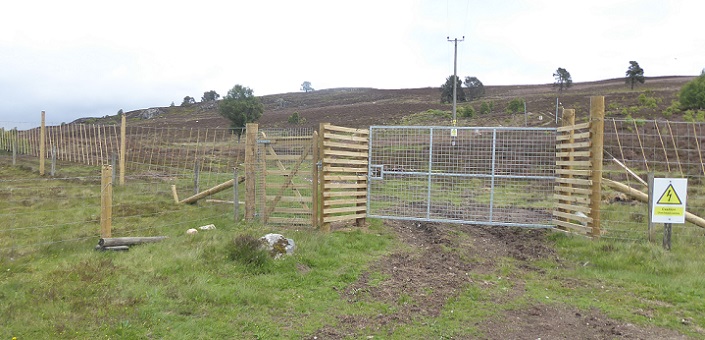
I started my walk at the road end Achnahannet where the newly enclosed area of moorland appears quite similar to the area covered by Phase 1 of BrewDog’s Lost Forest (see here), mature trees scattered over over the landscape and even from a distance extensive natural regeneration apparent.
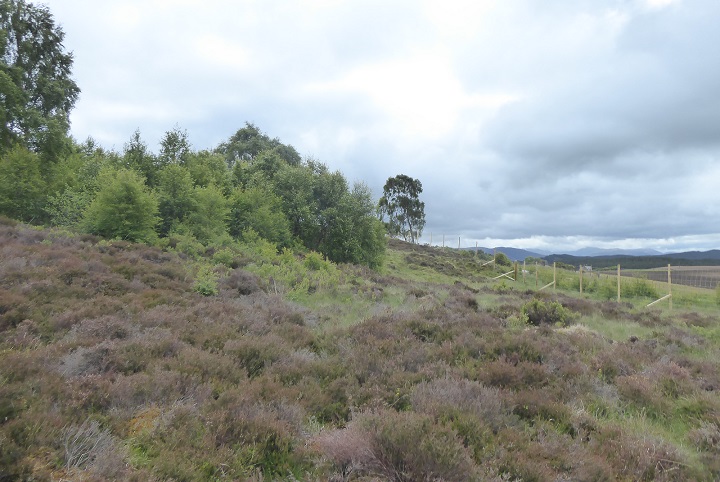
Both the old and the new natural regeneration is explained by the estate’s muirburn practices: while the majority of the land was affected, there were still large areas which were not burned. That allowed individual trees to survive and area of woodland to develop. As a result much of the area through which I walked would have developed into woodland very quickly through natural regeneration without any planting – as long as grazing levels had been kept low.

Just one small area along the route I walked were earmarked for natural regeneration – the area in the photo above by the road end (hard to see on the map). Almost all the rest was to be planted, mainly with Scots Pine.
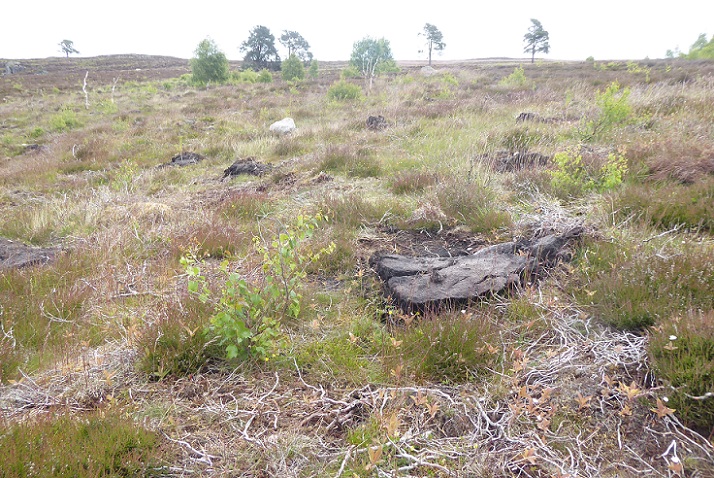
The stupidity of the contract agreed with Scottish Forestry should be apparent to anyone walking through the gate to take a closer look at what was happening on the ground. Mounds of peaty soil had been excavated to plant trees among an extensive area of recent natural regeneration. It appears that Scottish Forestry never bothered to inspect the land to check whether forking out £2,581,220 to plant trees was good use of public money. But then, as I have explained before, all Scottish Forestry are now interested in is meeting the Scottish Government’s targets for planting trees.

Just as with BrewDog’s Dead Forest (see here), a high proportion of the trees planted in the area near the gate had died, although that was not the case elsewhere along the route I took. Since most of the trees were planted this year, it is probably too early to tell how many have survived but in a sense that is irrelevant, with the extensive natural regeneration round about turning over these soils to leak carbon into the atmosphere was never justified.

Walking towards point 2, I did not cross the fence to take a closer look at all the young trees spreading across the hillside. I cannot say for certain therefore that they were not planted but most look too large to have been planted in the last year while the obvious mounding in the foreground, which was done over the last year, looks bare. Scottish Forestry should be forced to account why all this area was not reserved for natural regeneration on the Muckrach forest plan.
Through a Freedom of Information request to Scottish Forestry asking for all correspondence about the planting, I have obtained copies of emails from Savills, NatureScot, RSPB, Scottish Forestry and Calum Campbell, whose facebook post (see here) prompted my visit. The quotes that follow are from an email from Savills to Scottish Forestry dated 14th May and entitled “Mukrach (sic) Estate New Plantation Creation” – that just about sums up their project, plantation not woodland.
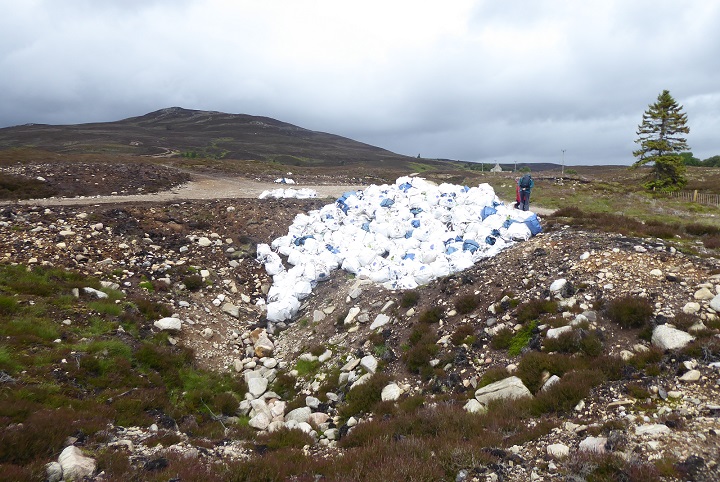
When we got to a fork in the road we came across what looked suspiciously like a dump – it almost looked as though someone intended to bury all these bags rather than re-use them. I was interested to find out afterwards, therefore that Savills had made the following claim to Scottish Forestry almost a month before our visit:

Savills may have been gathering up the bags but what they didn’t say that they hadn’t bothered to remove them from the site. In the intervening period a number had blown away. There were also a significant number of bags of unused fertiliser:

As if its not enough for the tree planting industry to destroy soils by turning them over, they then add fertiliser. These new plantations of native trees are anything but natural and should never have been allowed in the Cairngorms National Park.
Just by a pond excavated for duck shooting, there was a bank which illustrated much of what is wrong with this tree planting project:
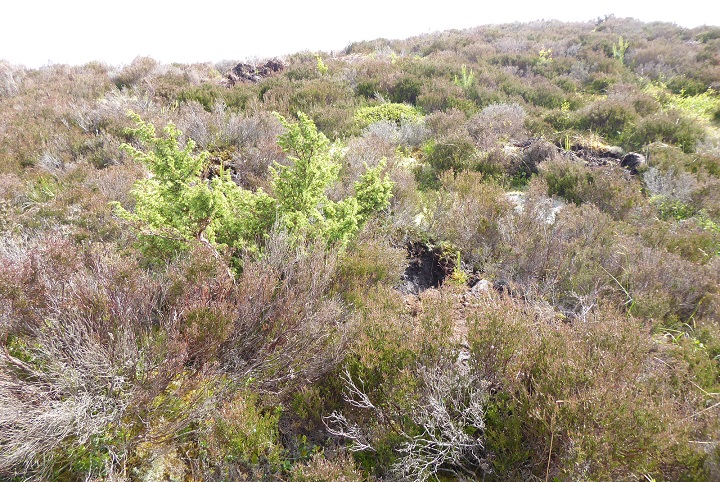
Despite a mixture of native deciduous trees successfully regenerating on this bank Scottish Forestry effectively agreed to pay Savills to replace them with Scots Pine (which eventually are likely to shade out the smaller trees). In my view this is tree planting vandalism but what does the senior management team in Scottish Forestry care as long as its meeting the Scottish Government’s tree planting targets? And what do Savills care so long as they are being paid?
While the digger operator appears to have made a reasonable attempt to scrape holes in between existing trees on this back, up by the newly excavated track we came across evidence of gorse being destroyed to plant trees:
There is an explanation as to why in some places native trees and shrubs have been destroyed to plant new one in the email from Savills to Scottish Forestry:

The claim that “there are several areas of natural regeneration on site” completely understates the truth but, having ignored its existence when submitting the grant claim, Savills then had to plant trees to meet the conditions of the grant. What a crazy and destructive use of public money!
In a further misuse of public money, the whole area has been enclosed with deer fencing despite the fact that deer density had been clearly low enough to enable trees to regenerate and woodland to develop naturally. Both perimeter fences have been marked with bamboo canes despite the fact that there is no evidence to suggest that this prevents birds like capercaillie flying into them. To give them credit, both RSPB and NatureScot in emails raised concerns about this fencing. Below is Savills reply to Scottish Forestry:
First, note the vague agreement between Savills and Scottish Forestry in which either wooden droppers or bamboo canes would be used to mark the fences: the first is proven to reduce (not end) the number of birds strikes, the second is not. Savills chose the second, unproven and much cheaper option.
Second, then Savills try and play off nature conservation v landscape interests saying that the CNPA had raised concerns about the impact of miles of fencing on the landscape. This is quite true, they did – I have a copy of their response to the grant application – but they also expressed concerns about the impact of fencing on wildlife.
The answer to this issue should have been quite obvious, continue to keep deer density to two per square km or less and there would be no need for any deer fences. That would have saved the public a whole lot of money, provided some long-term local employment, been far better for birds like capercaillie and black grouse – since even fences marked with wooden droppers kill – and far better for the landscape.
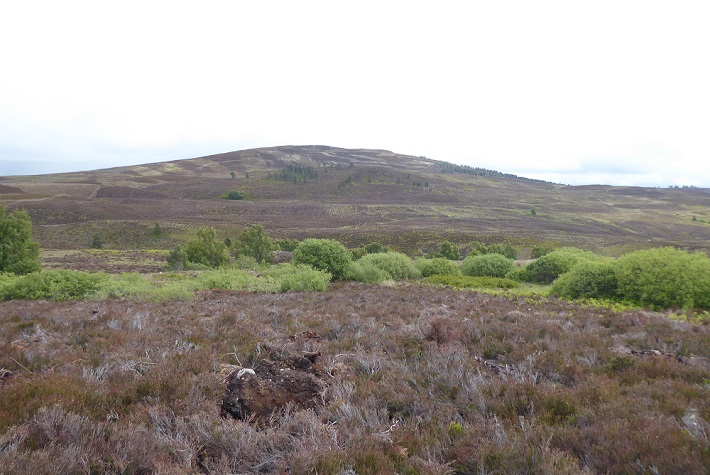
Walking towards the boundary with Lochindorb estate, the extent of the natural regeneration on the eastern side of Muckrach was clear to see. There was no planting needed here, only deer control and the area would have continued to develop naturally into woodland. Instead, a naturally diversifying landscape is to be turned into new monolithic plantations, mainly of those two a penny tree species, Scots Pine and birch..
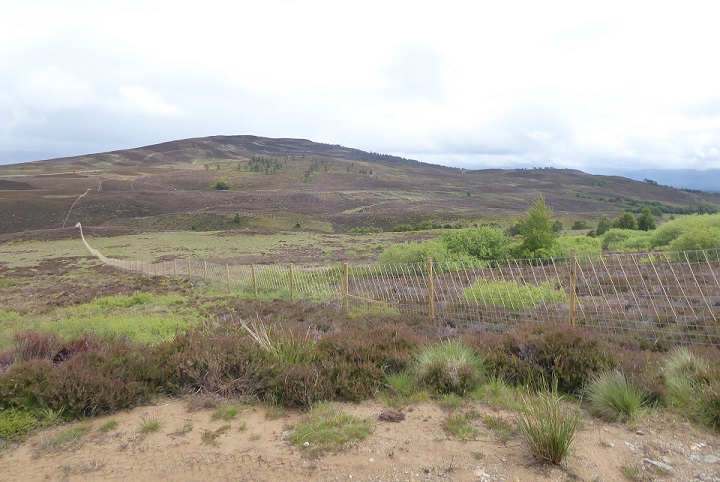
The CNPA was right, the deer fence has had a significant landscape impact. On the uphill side of the track it was the same:

While there were far fewer trees because of muirburn, the amount of bare ground that had created should have made it easy for trees to get established naturally. Instead, Savills with Scottish Forestry’s approval has created new areas of bare soil, through mounding, on which to plant trees.

The senselessness of the Scottish Government’s tree planting policy and the failure of the Cairngorms National Park Authority to facilitate landscape scale conservation was further illustrated at the boundary with Lochindorb. While Muckrach is now being paid to plant trees, with all the destruction that entails, the Lochindorb estate next door is still allowed to burn them.
A further post will consider further the impact the Muckrach woodland creation project will have on carbon emissions, the finances and the role of the Cairngorms National Park Authority.

I meant to comment on the first blog on Muckrach Estate tree planting. Well, done Calum and Nick for keeping this issue going. There is also an article dated 11 July in the Scotsman about this issue – see https://www.scotsman.com/hays-way/scottish-woodland-promised-to-be-exceptional-for-the-environment-causes-dewilding-after-damning-report-4697385.
Just when will the Scottish Government and its vassals – Scottish Forestry, NatureScot and CNPA learn? Are they even capable of learning from their mistakes – and there are so many! The first golden rule to learn is that if you set up a political/social/financial incentive environment, people and organisations will find ways of capitalising on it – in ways that were never intended. That’s why all such schemes need to be kept until critical review on an ongoing basis. Instead the Scottish Government agencies just report back to the Scottish Government what the politicians want to hear. They don’t realise that their job is to critically advise the Scottish Government, and when the politicians and senior civil servants don’t want to know – persist with their criticisms and improvement comments.
Other lessons they need to learn:
– They need to clearly prioritise natural regeneration over tree planting when considering any tree planting funding applications and associated planning permissions.
– There needs to be an assumption that tree fencing will not be permitted and that damage from deer is managed by controlling numbers.
– They need to get out and visit these schemes at the early stages and mid-stages on implementation and enforce compliance with the approved scheme
– They need to insist that the Scottish Government gives them the powers to not only get funded tree planting schemes ‘repaired’, where problems are found, but also to penalise these estates for not following the grant approved scheme or the planning rules – including insisting on repayment of all grant monies in full.
Unless it is clear to the estates that the agencies will enforce and penalise them for non-compliance, examples like Muckrach will continue to happen on a regular basis.
Lastly, I note the comment from CNPA that they were unaware of all the additional track works. This is ‘par for the course’ for CNPA Planning and yet another indicator of how dysfunctional planning enforcement is within the Park. Other examples are two developments within quarter of a mile from their Grantown offices. A retrospective planning application for the Grantown caravan site was approved after the owners had been asked to stop work, but then the planning department admitted that they were not aware that work had continued without planning permission. This was well reported in the Strathy. Secondly, and concurrently, just across the road from the caravan site, a housing developer was permitted to start work on a development which had 5 suspensive planning conditions not signed off. CNPA Planning needs a major management overhaul to get their people out of their offices and find out what is going on and start to penalise developers and estates who knowingly breach planning.
I was with Nick on the site visit in June and endorse everything he says in this post. Excellent comments also from Gordon, all good points. But we are long past the time when the existing system of forestry grant aid can be tweaked to resolve these problems. The evidence on the ground is clear – Scottish Forestry should be entirely stripped of its powers to grant aid this type of woodland in the hills. None of the recent controversial forestry schemes in the national park, on the Muckrach estate near Grantown, the BrewDog Kinrara estate by Aviemore and the abrdn/Standard Life Far Ralia estate by Kingussie and Newtonmore are for timber production. The crazy soil cultivation, pointless deer fencing and unnecessary tree planting is supposed to be for carbon capture and biodiversity recovery, all at a total cost to the public purse in excess of £6million. A fraction of that money, given to NatureScot rather than Scottish Forestry, would have produced far better benefits in terms of climate and biodiversity objectives, public enjoyment and community opportunity and employment. Tree planting needs to be focussed in the lowlands, where are greater variety of trees can be grown, far quicker and more cheaply, for timber and other purposes. But we must also ask why corporate interests, based in far away places, should be allowed to continue dictating the pattern of land use around our communities. We already have the legislation to change all this. Development Trusts need to be established in all the communities threatened by this type of forestry and for them to use the compulsory purchase powers contained within part 5 of the Land Reform (Scotland) Act 2016 to secure all the land at Muckrach, Kinrara and Far Ralia through community buy out. And the knowledge that such powers are going to be used to protect our national park will soon lead to a collapse in land prices within the park as the investors and their corporate bedfellows disappear over the far horizon.
From The Scotsman 11/7/24: https://www.scotsman.com/hays-way/scottish-woodland-promised-to-be-exceptional-for-the-environment-causes-dewilding-after-damning-report-4697385
Wait till you hear who the Savills Forestry Director used to work for. You might drop your patatas bravas and spill your sangria.
David Morris is correct. People need to appreciate that the administrative framework which has led to this fiasco has been very deliberately and systematically put in place within the Scottish Government and its agencies since the establishment of the public bodies responsible for Forestry in Scotland in 2019. The neoliberal agenda underlying this has been pursued with even greater zeal since COP26.
Andy, are the photographic images yours, you went on location, or from official reports?
I visited site and took photos,Nick
Thanks for highlighting this. The deer fencing, access tracks and gates are clearly not the most sensitive solution. Its great that there is concern for landscape / ecology impacts. However, you can’t make an omelette without breaking a few eggs! They are needed to re-establish woodland (a valid objective), unless there is reduction of herbivore grazing on a landscape scale, which may be a wider issue than the grant / subsidy / consent regimes. On the subject of which, perhaps it would be worth investing more energy in questioning why government subsidy continues to be used to fund the ecologically pervasive Scotland-wide problem of overgrazing of the uplands by sheep and roll out of the 5G network in wild land areas, which no-one actually needs and does nothing to address the climate and nature crises. Can I also suggest reviewing these planting sites once they have had a chance to establish? If nothing else the fencing should help with the natural regeneration. It may also be that, given increased risk of windthrow, mass Scots pine planting is not the best choice long term.
Robbie..I see your point but deer control is the obvious solution but that also goes against the neoliberalism mindset that pervades Scottish government thinking.
Ironically neoliberalism in land use such as farming and Forestry is dependant on subsidies from the tax payer.
Your comment about Scots pine and winblow is inaccurate in the sense that pine is much more windfirm than Sitka because it has deeper roots and less canopy.
Natural regeneration is of course the most windfirm of all forests.
Could someone please explain the problem with mounding, a standard forestry practice for many years? It used to be ploughing. Also suggest an alternative.
No sure I agree with windfirm natural regen as a generalisation either, though our horizontal birch & native Scots pine do send up vertical shoots.
Standard forestry practices may have been going on for many years but it is only relatively recently that the destruction they cause has been properly researched. There are two basic problems with mounding: first, it exposes the organic matter in soils to the atmosphere, the carbon reacts with the oxygen and it then releases CO2. This is a major problem with planting on peaty soils and is the reason why the Scottish Government has committed £250m to restoring peat bogs. Basically where vegetation cover has been damaged and the peat is exposed to the air they are trying to cover it up. The other factor however is the mounding, like ploughing, destroys the soil structure and more particular cuts up the mycorrhizal communities in the soil – while they help tree growth the fungi also store lots of carbon. There is some really interesting research on this by Friggens et al https://onlinelibrary.wiley.com/doi/10.1111/gcb.15229 which is not specific to mounding as most of the research plots started BEFORE mounding became common practice. Its conclusion is that planting trees like birch on upland soils, as has happened at Muckrach, may result in an net increase in carbon in the atmosphere for a period of at least 39 years. Unfortunately both the Scottish Forestry industry and the Scottish Government are both in denial about this. I hope this helps. Nick
It is actually the birch trees themselves that cause the Carbon loss via respiration from the soil, rather than ground cultivations as such, although they will probably speed this up. Birch is a soil improving species, promoting nutrient cycling and greater biological activity in the soil. In most cases this is good, but the down side is that it increases respiration from the soil, and with this, Co2 loss.
So, if you are interested in shelter, diversity of habitats, timber production, then trees are good. But if Co2 is your main aim, then the evidence is against you, at least with birch, less so with pine.
I dont think that Scottish Forestry are actually in denial. It is just that they realize what the implication is. Basically, if you dont allow planting on “carbon rich soils” (ie shallow peats > 5 cms depth), you potentially lose 90% of the potential planting ground available to you. The VAST majority of moorland soils in Scotland, excluding actual peatland, are carbon rich, and birch trees will recycle that carbon to the atmosphere. It does not matter whether the trees are planted on mounds, or direct planted without ground preps. The implication of this is that regenerated trees will have the same impact as well.
Inconvenient reality for lots of us.
Hi Victor, sorry I have conflated two points, one the effect that trees have on organic soil content and the other the impact of forestry techniques. What the Friggens research shows is that birch in particular appear, particularly in the period after planting (12 years or so) to increase the respiration rate of carbon from the soil. They postulate, as I understand them, that the young trees extract the nitrogen in the soils and this helps break down the organic content releasing carbon: as the nitrogen gets used up the process slows. At the same time they report that the type of mycorrhizal fungi found in the soil changes. Their research does not cover the impact of different planting techniques. However, we know that where peat is exposed to the atmosphere it reacts with oxygen to release CO2 so I suspect the carbon benefits of planting birch trees through mounding are even worse than the reported in the research. While you are quite right that the research shows planting Scots Pine does not release as much Soil Organic Carbon through respiration as birch, that is without taking mounding into account – I would contest your conclusion therefore, whatever the impact that Scots Pine have on soil organic carbon it will be less through natural regeneration than through mounding (and same for birch).
If you are interested in delivering Biodiversity, enhancing soils, better landscape aesthetics, varied recreational experiences, and want nature to regain some potency as a landscape jnfuencer then, in terms of cost-effectivesness,natural regeneration is massively superior to planting.. Just give nature time. Politicians and merchant bankers don’t want to give time…they have arbitrary and meaningless targets to achieve and quick profits to make …